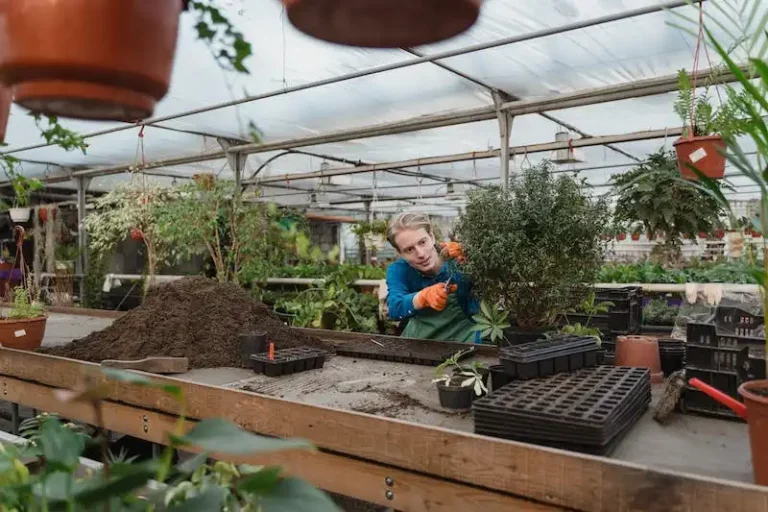Frost can be a real threat to many plants, including the beautiful chrysanthemums. These pale daisylike flowers, with their thick base and bronze-colored center, tend to bloom in the fall, which is when frost begins to appear in many climates. If you’re growing chrysanthemums or thinking about it, it’s important to know how to protect them during this time. In this article, we will share 7 tips on how to care for your chrysanthemums and ensure they survive even the coldest of frost.
1. Prepare them for the frost – Once September comes around, it’s time to start preparing your chrysanthemums for the colder weather. Start by deadheading the flowers to encourage new growth and remove any dead or dying ones. This will also help the plant focus its energy on surviving the frost.
2. Insulate the soil – When frost comes, the ground temperature can drop significantly. To help protect your chrysanthemums’ roots from freezing, add a thick layer of mulching around the base of the plant. This will insulate the soil and keep it a bit warmer, giving your chrysanthemums a better chance to survive.
3. Stake the plant – Chrysanthemums tend to grow tall and somewhat top-heavy, which can make them more susceptible to damage from frost and strong winds. To prevent them from toppling over, stake the plants early in the spring or when they are about a foot tall. This will provide added support and stability.
4. Don’t water them too much – While chrysanthemums need regular watering throughout the growing season, it’s important to reduce watering during the fall. This will help the plant naturally prepare for the colder temperatures and avoid any excess moisture that could freeze and damage the roots.
5. Provide additional protection – If the frost is particularly severe and you’re worried about your chrysanthemums, you can provide additional protection by covering them with a cloth or plastic sheet. Just make sure to secure the cover properly to prevent it from blowing away.
6. Follow local wisdom – Every area has its own unique climate, and gardeners in your area may have specific tips and tricks for protecting chrysanthemums during frost. Talk to local gardeners or visit a nearby nursery for advice specific to your region.
7. Enjoy the lasting beauty – Chrysanthemums are known for their long-lasting blooms. Even if some flowers do get damaged by frost, the plant will continue to produce new ones as the weather warms up in spring. So, don’t be discouraged if you see a few dead or wilted flowers; the perfect chrysanthemums will eventually come back.
In conclusion, chrysanthemums are able to tolerate frost to a certain extent, but they do need some protective care to ensure their survival. By following the tips mentioned in this article, you can keep your chrysanthemums safe during the colder months and enjoy their beautiful blooms year after year.
Hardy Mums for Cold Climates
In colder climates, where frost and freezing temperatures are common, it is essential to choose hardy mum varieties that can withstand these harsh conditions. While many mums are not suitable for surviving winter in colder areas, there are several varieties that are known for their ability to thrive in cold climates.
One of the hardiest mum varieties is the Indian Summer mum, also known as Chrysanthemum x morifolium. These mums are known for their ability to withstand frost and freezing temperatures. They tend to grow larger than other types of mums and are often used as a focal point in gardens.
Another cold-tolerant mum is the Clara Curtis mum. These mums have a long blooming period and can withstand colder temperatures. They are often used as cut flowers due to their beautiful blooms.
If you want hardy mums that can survive winter, it is important to provide them with proper care. Plant them in well-drained soil and make sure to water them regularly throughout the growing season. Mulching around the base of the plants can help insulate the roots and protect them from the cold.
In addition to proper care, there are several ways to protect your mums from frost and freezing temperatures. One way is to cover them with a frost blanket or burlap on colder nights. This can help trap heat and prevent frost damage.
Staking the plants before they reach their full height is another method that can help protect them from strong winds. This can prevent the plants from becoming damaged or toppling over in windy conditions.
Another popular method is to grow mums in containers. This allows you to move them indoors whenever there is a threat of frost or freezing temperatures. Simply bring the containers inside and place them in a sunny location, such as near a window or under a grow light.
In conclusion, choosing hardy mum varieties and providing them with proper care are essential for their survival in cold climates. By following the tips and methods mentioned above, you can ensure that your mums will thrive and continue to bloom year after year, even in the face of frost and freezing temperatures.
Classic Garden Mums
Garden mums, also known as chrysanthemums or “mums,” are a popular choice for gardeners looking to add a burst of fall color to their outdoor spaces. These hardy perennials can survive the winter and come back year after year, making them a low-maintenance option for creating a vibrant garden.
Classic garden mums, scientifically known as Chrysanthemum zawadskii, are a variety of mum that is full and compact in growth. Their foliage is hardy and can withstand frost, making them ideal for colder regions. With their naturally compact growth habit and dense foliage, classic garden mums provide excellent coverage and can be used as gorgeous border plants or in containers.
One reason why classic garden mums are such a popular choice among gardeners is their striking flower color. They come in a wide range of hues, including shades of yellow, orange, red, and even apricot. Their center disks can be a contrasting color, adding to the overall visual interest of the plant.
To ensure the survival of your classic garden mums throughout the winter, there are a few key steps you can take. First, pay attention to your local frost dates and be aware of when the first frost is likely to occur in your area. Next, mulching is important to insulate the soil and protect the roots from freezing. You can use compost or other organic mulch around the base of the plants to help retain moisture and provide insulation.
It’s also worth noting that classic garden mums are able to survive the winter even without deadheading the flowers. However, removing spent flowers can help redirect energy towards new growth in the following growing season. Additionally, garden mums can benefit from occasional feeding with a balanced fertilizer to promote healthy growth.
When planting classic garden mums, make sure to choose a location that receives full sun for at least six hours a day. The soil should be well-draining to prevent waterlogged roots, which can cause damage to the plant. If planting in containers, make sure to use a quality potting mix specifically formulated for outdoor plants.
In summary, classic garden mums are a popular and hardy choice for adding vibrant color to your garden. They can survive the winter and come back year after year, making them a low-maintenance option for gardeners of all experience levels. With proper care and attention, your classic garden mums will thrive and provide a beautiful display of fall color.
Other Hardy Garden Mums
In addition to the popular florist chrysanthemums, there are other varieties of mums that are more tolerant of frost and can survive colder winters. These hardy garden mums, also known as hardy chrysanthemums or garden hardy mums, are a great choice for gardeners looking to add some vibrant colors and blooms to their outdoor space.
One of the best ways to keep these hardy mums protected during frosty nights is to provide them with some daily care. Try to water them well before the first frost, and always avoid overhead watering, as it can lead to frost damage. It’s also a good idea to mulch around the base of the plants to help insulate them from the cold.
When it comes to planting hardy mums, choose a well-drained location that receives at least six hours of sunlight per day. Although they can tolerate some shade, mums generally prefer full sun for better blooming. Make sure to amend the soil with compost or organic matter before planting to improve drainage and fertility.
While hardy mums are perennials, they might not always come back year after year, especially if they are not well-suited to your local climate. To increase the likelihood of surviving winter, some gardeners prefer to transplant them to a more protected location or bring them indoors before the first frost hits.
Another option is to put mums in containers, which can be moved to a warmer spot whenever needed. This way, you can enjoy their beautiful flowers and compact size indoors and then move them back outdoors once the danger of frost has passed. Just make sure to water and care for them regularly.
One variety of hardy mums worth mentioning is the Indian Chimo. This hybrid chrysanthemum has received the Royal Horticultural Society’s Award of Garden Merit for its excellent performance and beautiful pink flowers. It blooms in late winter or early spring, bringing some much-needed color to the garden when most other plants are still dormant.
In conclusion, hardy garden mums are a wonderful addition to any garden, providing vibrant and long-lasting blooms. By following some simple care tips and protecting them from frost, these mums can thrive throughout the winter and come back stronger and more beautiful each year.
Other Hardy Chrysanthemums
While many chrysanthemums are not able to survive frost, there are several varieties that are more resilient and can withstand cold temperatures. These hardy chrysanthemums are a great addition to any garden, as they can provide color and beauty even during the colder months.
One such variety is the “Mary Stoker” chrysanthemum, which is known for its warm, pink and white flowers. This chrysanthemum can tolerate frost and will often bloom in the fall, while other varieties have already died back.
Another hardy chrysanthemum is the “Chimo” variety, which has a compact growth habit and can handle colder temperatures. This chrysanthemum is often grown in containers and can be overwintered indoors to protect it from frost.
When choosing hardy chrysanthemums for your garden, look for varieties that have thick foliage and strong stems. These traits will help the plant better withstand frost and prevent damage to the center.
To further protect your chrysanthemums from frost, you can take several measures. One way is to mulch around the base of the plant with a layer of straw or leaves, which will insulate the ground and keep the roots warm. Another way is to cover the plant with a thick layer of straw or burlap, particularly during periods of freezing temperatures. You can also move potted chrysanthemums indoors or to a greenhouse for added protection.
It’s important to note that hardy chrysanthemums may still show signs of frost damage, such as pale or wilted foliage. This is natural and the plant will often recover once the temperatures warm up.
When it comes to watering hardy chrysanthemums, it’s best to avoid overwatering, particularly during the colder months. These plants require less water while they’re dormant, so be sure to check the soil moisture before watering.
In conclusion, while many chrysanthemums are not able to survive frost, there are hardy varieties that can thrive in colder temperatures. By choosing the right plants and taking precautions to protect them, you can enjoy the beauty of chrysanthemums throughout the year.
Read more: source



